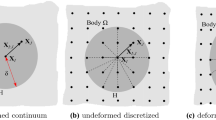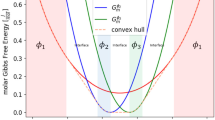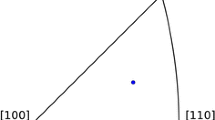Abstract
We present a thermodynamically consistent level sets approach based on regularization energy functional which can be directly incorporated into a Galerkin finite element framework to model interface motion. The regularization energy leads to a diffusive form of flux that is embedded within the level sets evolution equation which maintains the signed distance property of the level set function. The scheme is shown to compare well with the velocity extension method in capturing the interface position. The proposed level sets approach is employed to study the \(\upalpha \)–\(\upgamma \) phase transformation in RDX single crystal shocked along the (100) plane. Example problems in one and three dimensions are presented. We observe smooth evolution of the phase interface along the shock direction in both models. There is no diffusion of the interface during the zero level set evolution in the three dimensional model. The level sets approach is shown to capture the characteristics of the shock-induced \(\upalpha \)–\(\upgamma \) phase transformation such as stress relaxation behind the phase interface and the finite time required for the phase transformation to complete. The regularization energy based level sets approach is efficient, robust, and easy to implement.









Similar content being viewed by others
References
Adalsteinsson D, Sethian JA (1995) A fast level set method for propagating interfaces. J Comput Phys 118(2):269–277
Adalsteinsson D, Sethian JA (1999) The fast construction of extension velocities in level set methods. J Comput Phys 148(1):2–22
Allen SM, Cahn JW (1979) A microscopic theory for antiphase boundary motion and its application to antiphase domain coarsening. Acta Metall 27(6):1085–1095
Angheluta L, Jettestuen E, Mathiesen J, Renard F, Jamtveit B (2008) Stress-driven phase transformation and the roughening of solid–solid interfaces. Phys Rev Lett 100(9):096105
Barth TJ, Sethian JA (1998) Numerical schemes for the Hamilton–Jacobi and level set equations on triangulated domains. J Comput Phys 145(1):1–40
Barton NR, Winter NW, Reaugh JE (2009) Defect evolution and pore collapse in crystalline energetic materials. Model Simul Mater Sci Eng 17(3):035003
Bathe KJ (1996) Finite element procedures. Prentice-Hall, Upper Saddle River
Becker R (2004) Effects of crystal plasticity on materials loaded at high pressures and strain rates. Int J Plast 20(11):1983–2006
Birch F (1947) Finite elastic strain of cubic crystals. Phys Rev 71(11):809–824
Brooks AN, Hughes TJ (1982) Streamline upwind/Petrov–Galerkin formulations for convection dominated flows with particular emphasis on the incompressible Navier-Stokes equations. Comput Methods Appl Mech Eng 32(1–3):199–259
Caselles V, Catté F, Coll T, Dibos F (1993) A geometric model for active contours in image processing. Numer Math 66(1):1–31
Cawkwell MJ, Ramos KJ, Hooks DE, Sewell TD (2010) Homogeneous dislocation nucleation in cyclotrimethylene trinitramine under shock loading. J Appl Phys 107(6):063512
Cawkwell MJ, Sewell TD, Zheng L, Thompson DL (2008) Shock-induced shear bands in an energetic molecular crystal: application of shock-front absorbing boundary conditions to molecular dynamics simulations. Phys Rev B 78(1):014107
Choi CS, Prince E (1972) The crystal structure of cyclotrimethylenetrinitramine. Acta Crystallogr Sect B Struct Crystallogr Cryst Chem 28(9):2857–2862
Chopp DL (1993) Computing minimal surfaces via level set curvature flow. J Comput Phys 106(1):77–91
Connick W, May FGJ (1969) Dislocation etching of cyclotrimethylene trinitramine crystals. J Crys Growth 5(1):65–69
Davidson AJ, Oswald ID, Francis DJ, Lennie AR, Marshall WG, Millar DI, Pulham CR, Warrenc JE, Cumming AS (2008) Explosives under pressure—the crystal structure of \(\upgamma \)-RDX as determined by high-pressure x-ray and neutron diffraction. CrystEngComm 10(2):162–165
De S, Zamiri AR, Rahul (2014) A fully anisotropic single crystal model for high strain rate loading conditions with an application to \(\upalpha \)-RDX. J Mech Phys Solids 64:287–301
Dreger ZA, Gupta YM (2010) Phase diagram of hexahydro-1, 3, 5-trinitro-1, 3, 5-triazine crystals at high pressures and temperatures. J Phys Chem A 114(31):8099–8105
Dreger ZA, Gupta YM (2012) Decomposition of \(\upgamma \)-cyclotrimethylene trinitramine (\(\upgamma \)-RDX): relevance for shock wave initiation. J Phys Chem A 116(34):8713–8717
Gallagher HG, Halfpenny PJ, Miller JC, Sherwood JN, Tabor D (1992) Dislocation slip systems in pentaerythritol tetranitrate (PETN) and cyclotrimethylene trinitramine (RDX) [and Discussion]. Philos Trans R Soc Lond Ser A Phys Eng Sci 339(1654):293–303
Gurtin ME (1981) An introduction to continuum mechanics. Academic, New York
Hallquist JO (1993) LS-DYNA3D theoretical manual. Livermore Software Technology Corporation, 18.1-7
Hooks DE, Ramos KJ, Martinez AR (2006) Elastic-plastic shock wave profiles in oriented single crystals of cyclotrimethylene trinitramine (RDX) at 2.25 GPa. J Appl Phys 100(2):024908
Ji H, Chopp D, Dolbow JE (2002) A hybrid extended finite element/level set method for modeling phase transformations. Int J Numer Methods Eng 54(8):1209–1233
Josyula K, Rahul, De S (2014) Thermomechanical properties and equation of state for the \(\upgamma \)-polymorph of hexahydro-1, 3, 5-trinitro-1, 3, 5-triazine. RSC Adv 4(78):41491–41499
Juric D, Tryggvason G (1996) A front-tracking method for dendritic solidification. J Comput Phys 123(1):127–148
Landshoff R (1955) A numerical method for treating fluid flow in the presence of shocks. Los Alamos National Laboratory, Rept. LA-1930
Levitas VI, Javanbakht M (2015) Interaction between phase transformations and dislocations at the nanoscale. Part 1. General phase field approach. J Mech Phys Solids 82:287–319
Li C, Xu C, Gui C, Fox MD (2005) Level set evolution without re-initialization: a new variational formulation. In: 2005 IEEE computer society conference on computer vision and pattern recognition (CVPR’05), vol 1, pp 430–436
Li C, Xu C, Gui C, Fox MD (2010) Distance regularized level set evolution and its application to image segmentation. IEEE Trans Image Process 19(12):3243–3254
Lloyd JT, Clayton JD, Becker R, McDowell DL (2014) Simulation of shock wave propagation in single crystal and polycrystalline aluminum. Int J Plast 60:118–144
Lukyanov AA (2008) Constitutive behaviour of anisotropic materials under shock loading. Int J Plast 24(1):140–167
Luscher DJ, Addessio FL, Cawkwell MJ, Ramos KJ (2017) A dislocation density-based continuum model of the anisotropic shock response of single crystal \(\upalpha \)-cyclotrimethylene trinitramine. J Mech Phys Solids 98:63–86
Lynch DR, O’Neill K (1981) Continuously deforming finite elements for the solution of parabolic problems, with and without phase change. Int J Numer Methods Eng 17(1):81–96
Malladi R, Sethian JA, Vemuri BC (1995) Shape modeling with front propagation: a level set approach. IEEE Trans Pattern Anal Mach Intell 17(2):158–175
McDermott IT, Phakey PP (1971) A method of correlating dislocations and etch pits: application to cyclotrimethylene trinitramine. J Appl Crystallogr 4(6):479–481
Menikoff R, Sewell TD (2002) Constituent properties of HMX needed for mesoscale simulations. Combust Theory Model 6(1):103–125
Meyers MA (1994) Dynamic behavior of materials. Wiley, New York
Munday LB, Chung PW, Rice BM, Solares SD (2011) Simulations of high-pressure phases in RDX. J Phys Chem B 115(15):4378–4386
Olinger B, Roof B, Cady H (1978) The linear and volume compression of \(\upbeta \)-HMX and RDX to 9 GPa (90KiloBar). In: Symposium International Sur Le comportement Des Milieux Denses Sous Hautes Pressions Dynamiques, pp 1–7
Osher S, Fedkiw RP (2001) Level set methods: an overview and some recent results. J Comput Phys 169(2):463–502
Osher S, Sethian JA (1988) Fronts propagating with curvature-dependent speed: algorithms based on Hamilton–Jacobi formulations. J Comput Phys 79(1):12–49
Patterson JE, Dreger ZA, Gupta YM (2007) Shock wave-induced phase transition in RDX single crystals. J Phys Chem B 111(37):10897–10904
Peng D, Merriman B, Osher S, Zhao H, Kang M (1999) A PDE-based fast local level set method. J Comput Phys 155(2):410–438
Ramos KJ, Hooks DE, Bahr DF (2009) Direct observation of plasticity and quantitative hardness measurements in single crystal cyclotrimethylene trinitramine by nanoindentation. Philos Mag 89(27):2381–2402
Rao VS, Hughes TJ, Garikipati K (2000) On modelling thermal oxidation of silicon II: numerical aspects. Int J Numer Methods Eng 47(1–3):359–377
Rider WJ, Kothe DB (1998) Reconstructing volume tracking. J Comput Phys 141(2):112–152
Schreiber E, Anderson OL, Soga N (1973) Elastic constants and their measurement. McGraw-Hill, New York
Sethian JA (1996) A fast marching level set method for monotonically advancing fronts. Proc Natl Acad Sci 93(4):1591–1595
Sethian JA (1999) Level set methods and fast marching methods. Cambridge University Press, Cambridge
Sewell TD, Bennett CM (2000) Monte Carlo calculations of the elastic moduli and pressure–volume–temperature equation of state for hexahydro-1, 3, 5-trinitro-1, 3, 5-triazine. J Appl Phys 88(1):88–95
Simo JC, Hughes TJR (1998) Computational inelasticity. Springer, New York
Stolarska M, Chopp DL, Moës N, Belytschko T (2001) Modelling crack growth by level sets in the extended finite element method. Int J Numer Methods Eng 51(8):943–960
Sussman M, Smereka P, Osher S (1994) A level set approach for computing solutions to incompressible two-phase flow. J Comput Phys 114(1):146–159
Truesdell C (1984) Rational thermodynamics. Springer, Berlin
Udaykumar HS, Mittal R, Shyy W (1999) Computation of solid–liquid phase fronts in the sharp interface limit on fixed grids. J Comput Phys 153(2):535–574
Von Neumann J, Richtyer RD (1950) A method for the numerical calculation of hydrodynamic shocks. J Appl Phys 21(3):232–237
Winey JM, Gupta YM (2006) Nonlinear anisotropic description for the thermomechanical response of shocked single crystals: inelastic deformation. J Appl Phys 99(2):023510
Yamasaki S, Nishiwaki S, Yamada T, Izui K, Yoshimura M (2010) A structural optimization method based on the level set method using a new geometry-based re-initialization scheme. Int J Numer Methods Eng 83(12):1580–1624
Zhao HK, Chan T, Merriman B, Osher S (1996) A variational level set approach to multiphase motion. J Comput Phys 127(1):179–195
Acknowledgements
This work has been supported in part by the Office of Naval Research (ONR) Grants N000140810462 and N000141210527 with Dr. Cliff Bedford as the cognizant program manager.
Author information
Authors and Affiliations
Corresponding author
Rights and permissions
About this article
Cite this article
Josyula, K., Rahul & De, S. A level set approach for shock-induced \(\upalpha \)–\(\upgamma \) phase transition of RDX. Comput Mech 61, 19–32 (2018). https://doi.org/10.1007/s00466-017-1493-1
Received:
Accepted:
Published:
Issue Date:
DOI: https://doi.org/10.1007/s00466-017-1493-1




